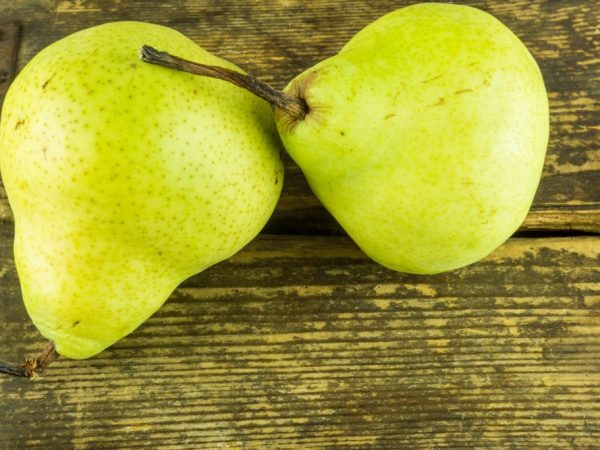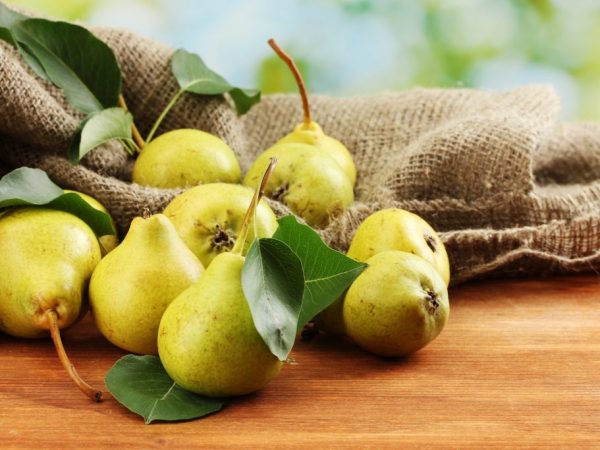Characteristics of the pear variety Kudesnitsa
Pear Kudesnitsa was bred in Belarus as a hybrid that brought together the best qualities of three varieties - Sapezhanka, Druzhba and Lagodnaya. Its high yield and excellent taste have made this variety popular among many gardeners.

Characteristics of the pear variety Kudesnitsa
Variety characteristic
The fruits of this sotra have a short shelf life (1-3 weeks in the cold) and are not suitable for long-term transportation. This is the only disadvantage of the variety. But a bountiful harvest and an excellent taste of the fruit completely compensate for this shortcoming.
Pear variety Kudesnitsa has the following characteristics:
- Early maturity - fruits are formed as early as 3 years after planting a one-year seedling.
- High yield - one hectare can yield up to 20 tons of fruits.
- Winter hardiness - tolerates frost well in the middle zone.
- Unpretentious care - trees of this variety require only minimal care in the form of watering during a drought, spraying from pests and annual pruning of the crown.
Unlike many other varieties of pears, this variety does not require pollinators to be adjacent to trees and itself can fulfill this role if necessary.
Description of the tree
According to its external characteristics, the tree is vigorous (can reach up to 4 m), with a wide pyramidal crown of medium density.
The branches are strong and long. With insufficient pruning, they can shade each other. This negatively affects the yield, as well as the maturity of the fruit.
The bark of the tree is dark brown, indented with small grooves. The ends of the branches are slightly grayish.
Description of the fetus
The description shows that the fruits of the Witchcraft are juicy and aromatic, with a rich sweet taste. Fruits of this variety are widely used for the preparation of compotes, preserves, jams, candied fruits, marmalade, tinctures and wine. The fragrant fruits have also found their application in folk medicine and pharmacology.

Fruits are green, weighing 160-200 g)
Features of pear sorceress:
- truncated cone shape;
- rather large size (can reach 160-200 g);
- the skin is smooth and shiny, of medium thickness;
- the fruit is green, there may be a slight blush;
- the pulp is pale green, fine-grained, juicy, semi-oily;
- the fruit is sweet, rarely with a slight sourness.
The variety belongs to summer, ripening and harvesting of fruits is carried out in August.
Growing
The best place for disembarkation is an area closed from the cold wind, without stagnant moisture. The plant does not tolerate direct sunlight, but prefers well-lit places. Therefore, for planting, one should prefer the western or southwestern side.
The plant is not particularly demanding on the soil, but it grows best on loose, fertile soil without stagnant moisture. Before planting, it is recommended to additionally add organic fertilizers to the soil and dig it deeply. The best landing time will be the end of October - November.
Care
For trees of this variety, artificial irrigation (sprinkling) is ideal, which helps to moisten the surface air layer and reduce its temperature. In case of prolonged drought, it is recommended to water the tree in the trunk circle at the rate of 3 buckets per 1 m2.

For a rich harvest, it is necessary to properly care for the pear.
The tree needs to loosen the soil after it has been moistened. For greater productivity, organic and mineral fertilizers (humus, slaked lime, wood ash) can be applied to the soil.
For the correct formation of the crown, annual pruning is performed (it is better to do it in early spring or late autumn). All dry and damaged branches are also removed.
Pests and diseases
The complex of pear care also includes spraying the plant from pests. This prevents the worminess of the fruit and the caterpillars from eating the foliage.
The description of the variety shows that among the pests, gall midges, gall mites, aphids, hawthorns, honey beetles, flower beetles, moths, pruritus, ticks, pipe beetles, moths, etc. are especially dangerous. , remove fallen leaves and plant debris.
The variety is at risk of being affected by similar diseases:
- Scab is a fungal disease that affects fruits and leaves. For prevention, spraying with 1% Bordeaux liquid and airing the crown is applied three times.
- Fruit rot (moniliosis) is a fungus that forms brown spots and grayish growths on fruits. To prevent the spread of the fungus, 1% Bordeaux liquid and lime milk for the leaves are also used.
- Sooty fungus is a disease in which leaves and fruits turn black. Fitoverm is used to suppress the reproduction of this fungus.
- Powdery mildew is a fungus that infects leaves, inflorescences and young shoots. As a preventive measure, a solution of soda ash with liquid soap is used.
Conclusion
The Kudesnitsa varieties are distinguished by early maturity, winter hardiness, unpretentious care, high yield, aroma and bright taste of fruits. That is why many gardeners pick such a pear.


